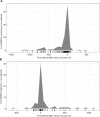Noninvasive screening identifies patients at risk for spontaneous bacterial peritonitis caused by multidrug-resistant organisms
- PMID: 30464547
- PMCID: PMC6223386
- DOI: 10.2147/IDR.S172587
Noninvasive screening identifies patients at risk for spontaneous bacterial peritonitis caused by multidrug-resistant organisms
Abstract
Background and aims: Spontaneous bacterial peritonitis (SBP) is a severe complication of decompensated cirrhosis. The prevalence of multidrug-resistant organisms (MDROs) in patients with cirrhosis is increasing. Identification of patients at risk for SBP due to MDROs (ie, SBP with the evidence of MDROs or Stenotrophomonas maltophilia in ascitic culture, MDRO-SBP) is crucial to the early adaptation of antibiotic treatment in such patients. We therefore investigated whether MDROs found in ascitic cultures can also be found in specimens determined by noninvasive screening procedures.
Patients and methods: This retrospective study was conducted at the liver center of the University Hospital Frankfurt, Germany. Between 2011 and 2016, patients with cirrhosis were included upon diagnosis of SBP and sample collection of aerobic/anaerobic ascitic cultures. Furthermore, the performance of at least one complete MDRO screening was mandatory for study inclusion.
Results: Of 133 patients diagnosed with SBP, 75 (56.4%) had culture-positive SBP and 22 (16.5%) had MDRO-SBP. Multidrug-resistant Escherichia coli (10/22; 45.5%) and vancomycin-resistant enterococci (7/22; 36.4%) resembled the major causatives of MDRO-SBP. Rectal swabs identified MDROs in 17 of 22 patients (77.3%) who developed MDRO-SBP with a time-dependent sensitivity of 77% and 87% after 30 and 90 days upon testing, while negative predictive value was 83% and 76%, respectively. The majority of patients were included from intensive care unit or intermediate care unit.
Conclusion: MDRO screening may serve as a noninvasive diagnostic tool to identify patients at risk for MDRO-SBP. Patients with decompensated cirrhosis should be screened for MDROs from the first day of inpatient treatment onward.
Keywords: antibiotic therapy; ascites; liver cirrhosis; multidrug resistance; screening routine.
Conflict of interest statement
Disclosure SZ has provided consultancy for Abbvie, BMS, Gilead, Intercept, Janssen and Merck (all outside the scope of this study). OW has provided consultancy for Amgen, Bayer, BMS, Celgene, Eisai, Merck, Novartis, Roche, Servier and Shire (all outside the scope of this study). VAJK was partially supported by a grant from the Deutsche Forschungsgemein-schaft (DFG, research unit 2251). The authors report no other conflicts of interest in this work.
Figures


Similar articles
-
Quinolone and Multidrug Resistance Predicts Failure of Antibiotic Prophylaxis of Spontaneous Bacterial Peritonitis.Clin Infect Dis. 2020 Apr 15;70(9):1916-1924. doi: 10.1093/cid/ciz540. Clin Infect Dis. 2020. PMID: 31228250
-
Patients with cirrhosis and SBP: Increase in multidrug-resistant organisms and complications.Eur J Clin Invest. 2020 Feb;50(2):e13198. doi: 10.1111/eci.13198. Epub 2020 Jan 21. Eur J Clin Invest. 2020. PMID: 31886517
-
Rectal colonization by resistant bacteria increases the risk of infection by the colonizing strain in critically ill patients with cirrhosis.J Hepatol. 2022 May;76(5):1079-1089. doi: 10.1016/j.jhep.2021.12.042. Epub 2022 Jan 22. J Hepatol. 2022. PMID: 35074475
-
Spontaneous bacterial and fungal peritonitis in patients with liver cirrhosis: A literature review.World J Hepatol. 2018 Feb 27;10(2):254-266. doi: 10.4254/wjh.v10.i2.254. World J Hepatol. 2018. PMID: 29527261 Free PMC article. Review.
-
Management of Multidrug-Resistant Infections in Cirrhosis.Semin Liver Dis. 2022 May;42(2):173-187. doi: 10.1055/a-1765-0056. Epub 2022 Feb 7. Semin Liver Dis. 2022. PMID: 35130574 Review.
Cited by
-
Fluoroquinolones for the Prophylaxis of Spontaneous Bacterial Peritonitis in Patients with Liver Cirrhosis: Are They Losing Ground?Life (Basel). 2025 Apr 2;15(4):586. doi: 10.3390/life15040586. Life (Basel). 2025. PMID: 40283141 Free PMC article. Review.
-
The Mucosally-Adherent Rectal Microbiota Contains Features Unique to Alcohol-Related Cirrhosis.Gut Microbes. 2021 Jan-Dec;13(1):1987781. doi: 10.1080/19490976.2021.1987781. Gut Microbes. 2021. PMID: 34747331 Free PMC article.
-
Molecular Surveillance of Carbapenem-Resistant Gram-Negative Bacteria in Liver Transplant Candidates.Front Microbiol. 2021 Nov 22;12:791574. doi: 10.3389/fmicb.2021.791574. eCollection 2021. Front Microbiol. 2021. PMID: 34880850 Free PMC article.
-
Antimicrobial resistance in patients with decompensated liver cirrhosis and bacterial infections in a tertiary center in Northern Germany.BMC Gastroenterol. 2021 Jul 20;21(1):296. doi: 10.1186/s12876-021-01871-w. BMC Gastroenterol. 2021. PMID: 34284732 Free PMC article.
-
Burden, risk factors, and outcomes of multidrug-resistant bacterial colonisation at multiple sites in patients with cirrhosis.JHEP Rep. 2023 May 11;5(8):100788. doi: 10.1016/j.jhepr.2023.100788. eCollection 2023 Aug. JHEP Rep. 2023. PMID: 37484213 Free PMC article.
References
-
- Fernández J, Acevedo J, Castro M, et al. Prevalence and risk factors of infections by multiresistant bacteria in cirrhosis: a prospective study. Hepatology. 2012;55(5):1551–1561. - PubMed
-
- Garcia-Tsao G. Current Management of the Complications of Cirrhosis and Portal Hypertension: Variceal Hemorrhage, Ascites, and Spontaneous Bacterial Peritonitis. Dig Dis. 2016;34(4):382–386. - PubMed
-
- Arvaniti V, D’Amico G, Fede G, et al. Infections in patients with cirrhosis increase mortality four-fold and should be used in determining prognosis. Gastroenterology. 2010;139(4):1246–1256. - PubMed
LinkOut - more resources
Full Text Sources

